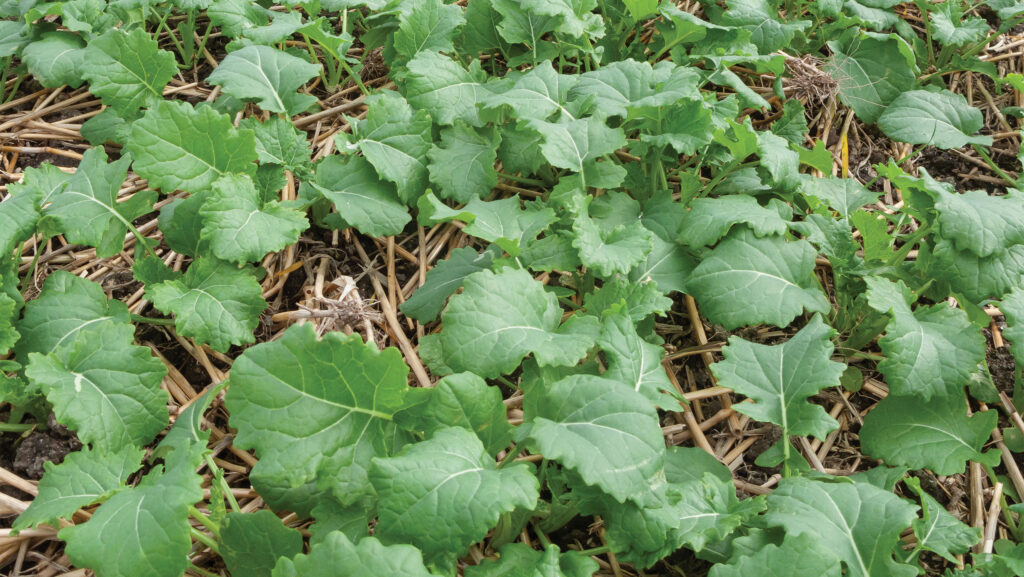OSR growers advised to apply PGR to very forward crops
 © Blackthorne Arable Ltd
© Blackthorne Arable Ltd Oilseed rape growers are being advised to apply a plant growth regulator (PGR) to some of the most forward OSR crops seen, in order to maximise yields and crop resilience.
It’s not just the size of some, but this autumn is seeing a huge range in growth stages from six true leaves to those at the cotyledon stage.
See also: Why propyzamide use in OSR and beans remains in the balance
Consequently, management will be more challenging with a field-by-field approach needed, according to Procam regional technical manager Nigel Scott.
He says the main aim is to achieve a green area index of 3.5 by flowering to maximise yield.
And while farmers are reluctant to spend money, some missed out on yield last summer by not investing with fresh memories of crop failures in the previous season.
Key benefits of an autumn PGR on forward crops
- Roots: Helps stimulate root growth and makes crops more resilient to extreme wet and dry conditions in the coming months
- Root collar: Crops with a bigger root collar diameter are more tolerant of cabbage stem flea beetle larval damage
- Protect buds: In the autumn, crops start to produce flower buds and you don’t want them exposed to weather. A plant growth regulators helps keep the growing point lower to ground, so are better protected
Why so variable?
So why are agronomists seeing such variable crops? Looking back 10 years, Nigel highlights that the average drilling date was the third week of August.
But the cabbage stem flea beetle threat means there has been a shift to earlier or later drilling to avoid crops being at the cotyledon stage when adult flea beetles emerge in the latter part of August.
This year, some were drilled earlier still. He points to his part of County Durham, which, like other parts of the UK, saw an early end to harvest.
Consequently, some were tempted to get OSR in the latter part of July and early August.
Those plants that found moisture are flying along. However, where there was no moisture or if seed-beds dried out, emergence has been protracted.
So there is a large range of crop growth that is down to moisture, resulting in crops at four, five and six true leaves, along with some just at the cotyledon stage.
The latest were drilled after migration in September and these are at one true leaf. The concern is that Nigel is starting to see significant numbers of adult beetles.
“Some fields are being written off,” he says.
“So in conclusion, we are seeing crops at three different growth stages, even in the same field.”
Growth regulators
With the more forward crops, his growers are planning to apply a plant growth regulator – something they haven’t had to do for a long time.
Options include straight metconazole or Caryx (metconazole + mepiquate-chloride).
He points out that farmers need to apply a plant growth regulator (PGR) now to get the most out of the application and not leave it too late.
Ideally, this is best applied with plants at four to six true leaves (mid-October). The growth regulator stops top growth and promotes rooting (see panel).
Moving to disease, Nigel is already seeing phoma, but it is less of a problem in forward crops.
This is because the risk of the disease reaching stems and causing cankers is reduced with the longer leaf petioles.
“It’s more of an issue in smaller crops and these will receive a fungicide like difenoconazole.”
His final tip is to apply nutrients to backward crops, as soils will be cooling and there is a need to build biomass ready for the winter.
“Even forward crops will benefit from some nutrition, especially manganese and boron to maximise yields.”
Timing clethodium applications
One key challenge this autumn will be timing clethodim applications in variable crops to manage grassweeds.
Some fields have plants at the four, five and six true leaves along with those at one true leaf.
Timing is a problem, as it can cause damage in big crops. “So growers will need to be on the ball with application timings,” says Nigel.
Reasons for forward OSR crops
Why Nigel Scott is seeing the most forward OSR crops he has ever seen?
He believes it’s a combination of factors including earlier drilling and higher soil temperatures.
“Soils are still warm after the warm summer and there hasn’t been the rainfall to cool them.”
He also suspects there is more residual soil nitrogen because of the dry summer, so plants have had a bit of help. Warm soils also mean more mineralisation.
Another factor is that 80% of crops he overseas have a companion, mostly straight buckwheat.
“The buckwheat has grown above the canopy and is pulling OSR up with it due to crop competition. Those without the buckwheat are not as big.”

